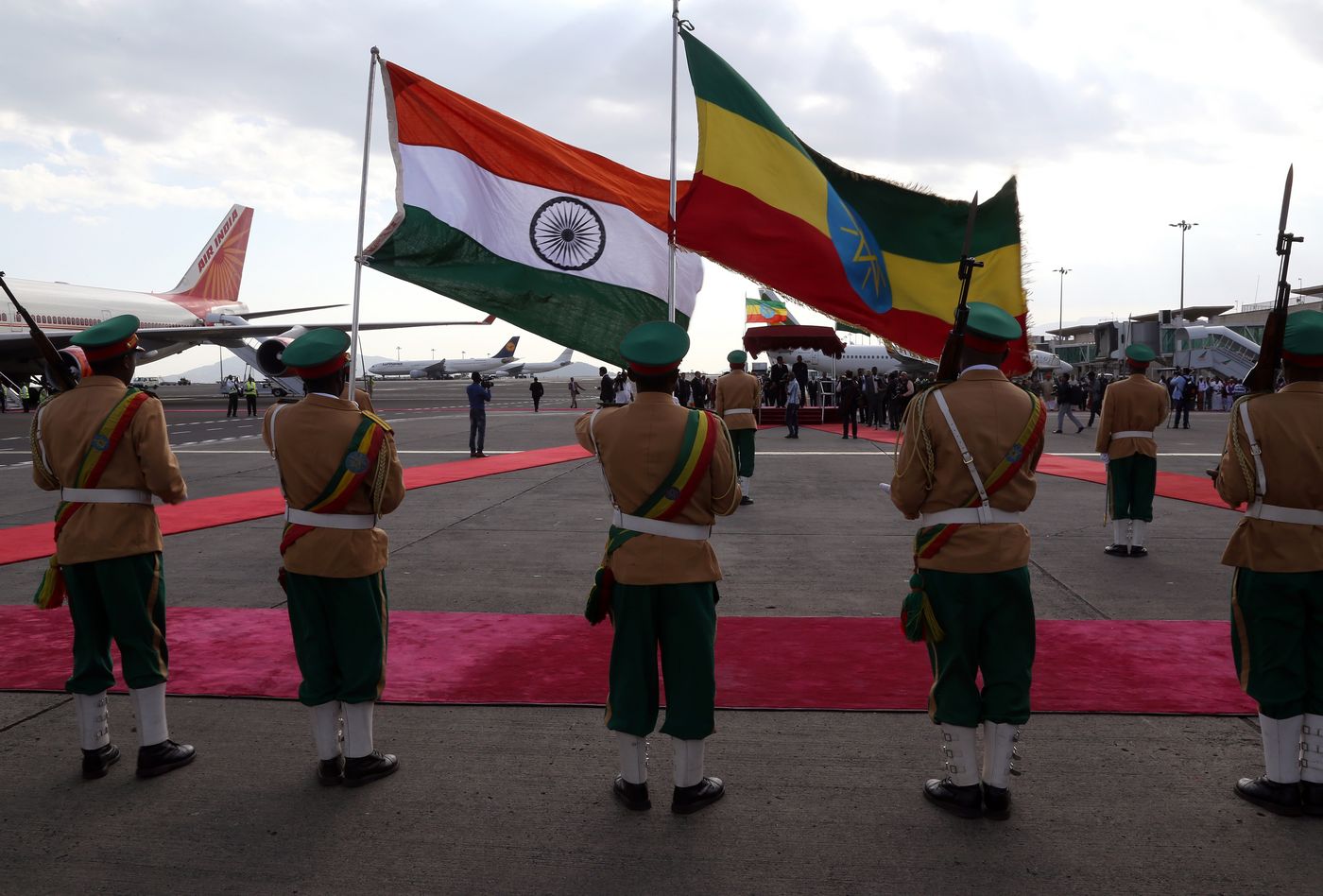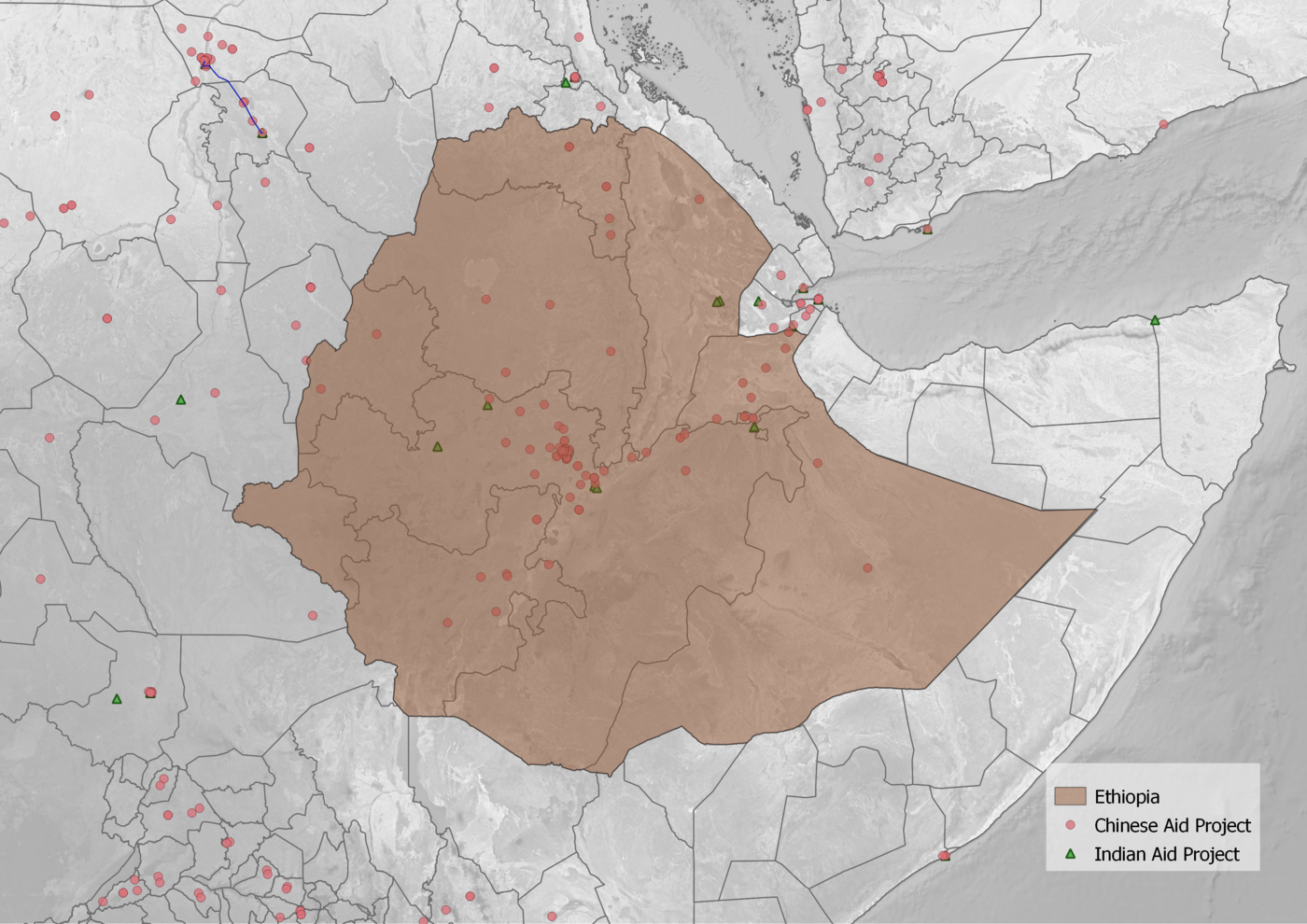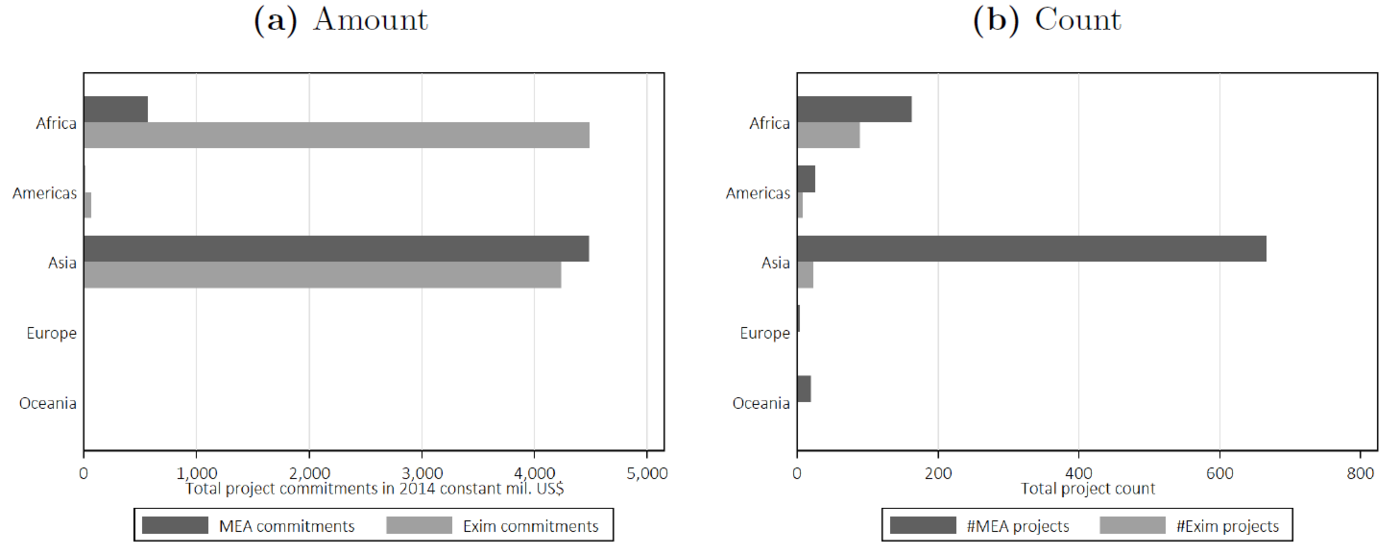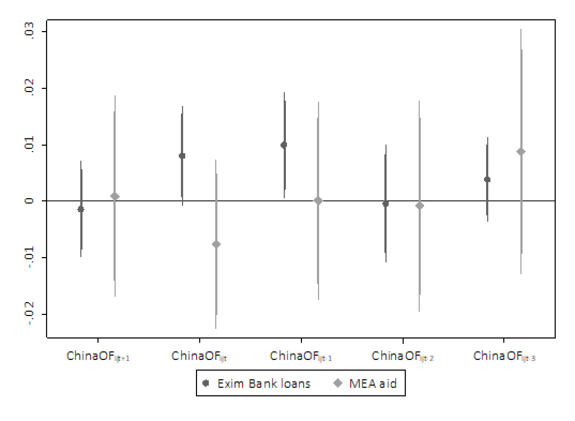Is India the New China? Rivalries in Development Finance in Africa and Beyond
Megatrends spotlight 20, 09.01.2023India prioritizes Africa and Asia in its allocation of development projects to the Global South. Our research shows that India tends to make financial commitments in areas where China has increased its activities. This appears to be driven by commercial competition, Gerda Asmus (University of Göttingen), Vera Z. Eichenauer (ETH Zurich), Andreas Fuchs (University of Göttingen and IfW Kiel), and Bradley Parks (William & Mary) write in this Megatrends Afrika Spotlight.

The Indian and Ethiopian flags are displayed during a state visit by then Indian president Ram Nath Kovind in Addis Ababa in 2017.
© Minasse Wondimu Hailu / Anadolu Agency via AFP
Most African countries cultivate relationships with a multitude of donor countries beyond the group of Western donors. A case in point is Ethiopia (Figure 1), a long-time darling of many donors from the West and East. Chinese loans, for example, supported the construction of Africa's first railway academy and several Ethiopian railways. Chinese contractors oversaw the implementation of even more infrastructure projects which were financed by Beijing but also by other donors such as the World Bank. India also participates in the Ethiopian donor bustle. In 2013, for example, the Indian Exim Bank extended a loan of US$300 million to finance a railway line from Asaita to Tadjoura in neighboring Djibouti.

Figure 1: Geocoded Indian and Chinese development projects in Ethiopia (2000/07 – 2014). Source: Asmus et al. 2021.
© Die Autor*innen
Assessing the role of Eastern donors in development finance
Ethiopia is only one of many African countries to benefit from Eastern donors' development finance. India's ambitions on the African continent have been growing especially. Recently, Foreign Policy asked "Is India the New China in Africa?" Former Mozambican minister Joaquim Tobias Dai argued: "We have China and India fighting for resources in Africa. [...] The Chinese want to go for gas, but Indians want to go for gas as well. This kind of competition is good for us" (Khare 2013).
Various studies suggest that India and China use grants and concessional loans to curry favor with developing countries in their neighborhood and Sub-Saharan Africa (Fuchs and Vadlamannati 2013; Dreher et al. 2019). According to Kragelund (2010), India began targeting African countries as early as the 1960s "as a direct consequence of the competition with China." Hart and Jones (2010, 73) note that "[i]n the run-up to the 2005 World Summit, […] China used its financial influence to press many African states into siding against India's bid for a UN Security Council seat." However, it is still unclear if these emerging powers make systematic use of aid and credit as tools of strategic rivalry between each other. To address this research gap, we constructed a novel dataset of 1,194 Indian development projects in 4,308 different locations around the globe between 2007 and 2014 – and added information on the locations of Chinese development projects (Bluhm et al. 2020; Dreher et al. 2021).
How does India react to China's expanding footprint in global development
In a new working paper (Asmus et al. 2021), we examine the relationship between grants and loans from India and China to developing countries. We hypothesize that India likely follows Beijing's actions, given that Beijing oversees a substantially larger portfolio of overseas development projects (Asmus, Fuchs and Müller, 2020).
India may compete with China for both commercial and geopolitical reasons. Therefore, we analyzed the reactions of India's Ministry of External Affairs (MEA) and the more commercially oriented Indian Export-Import (Exim) Bank separately (Figure 2). Within Africa, the countries receiving the most Indian projects are Liberia, Ghana, Malawi, Mauritius, and Mozambique. While the MEA supports a larger number of projects, the Exim Bank provides more support in monetary terms (Figure 2).

Figure 2: Comparing (a) monetary amounts and (b) project numbers by the Indian Export-Import (Exim) Bank and the Indian Ministry of External Affairs (MEA) across world regions (2007-2014). Source: Asmus et al. 2021
© Die Autor*innen

Figure 3: Timing of the reaction of India's Export-Import (Exim) Bank and Ministry of External Affairs (MEA) to new Chinese projects. Notes: The figure shows the percentage point differences in the likelihood of an Indian Exim or MEA project being allocated in response to a Chinese-funded project. Coefficients are based on regression results of Column 6 of Table 1 in Asmus et al. 2021.
© Die Autor*innen
India's Exim Bank locates projects in the same provinces as Chinese projects
Our analysis shows that when the Chinese government increases its financial footprint in a given province, India's Exim Bank tends to respond by approving a project in the very same province (Figure 3). Quantitatively, the receipt of a new Chinese government-financed project more than doubles the probability of a province becoming a recipient of credit from India's Exim Bank in the following year. This provides evidence in favor of localized competition, although we find only weak evidence of competition at the national level.
Our main finding for the Indian Exim Bank replicates when using the logarithm of the project count or total annual financial flows to a province. We find that the positive relationship between Indian Exim Bank projects and Chinese projects in the previous year is driven by the reaction to commercially-oriented Chinese government projects rather than official development assistance (ODA) from China.
However, we find no evidence that India's MEA engages in competition with China in the average recipient country – not even in response to China's more politically-oriented aid projects. This is different only in those areas where New Delhi's values influence the most: in its neighborhood in South Asia.
Is New Delhi competing with Beijing, but not the other way around?
We interpret these findings as evidence that India competes with China using credit through its Exim Bank. Additional evidence derives from a comparison to public opinion data from the Gallup World Poll. We find that the Government of India is more likely to increase its financial footprint in jurisdictions where it is more popular relative to China. This is a pattern that is difficult to reconcile with any explanation other than the competition with China.
However, the competition seems to be rather one-sided. We find no evidence that Beijing steps up its development activities when India launches new projects in countries and provinces, nor are there signs of a crowding-in of Chinese development projects in response to new Indian project commitments. Thus, we conclude that China does not systematically use development finance as a tool of competition with India.
Pros and cons of donor competition in the development sector
Based on this robust evidence, we conclude that India is engaging primarily in commercial rather than geopolitical competition with China. The Indian Exim Bank responds to new Chinese projects by green-lighting projects in the very same provinces (and to a lesser extent elsewhere in the given country). By contrast, development aid provided by India's Ministry of External Affairs does not follow China's development activities in the average recipient country – outside of South Asia.
We find that competition is more fierce for India in countries where New Delhi is more popular relative to China. India thus increases its spending in jurisdictions where it risks losing its dominant position. This is not surprising as ample evidence exists that favorable public opinion promotes bilateral trade (Disdier and Mayer 2007; Guiso, Sapienza, and Zingales 2009; Rose 2019).
Still, it is an open question how donors use aid to shift public opinion in their favor in situations of rivalry. The effect of development finance on public opinion is not straightforward. As we show in Eichenauer, Fuchs, and Brückner (2021) for Latin America, the effects of Chinese development finance and other economic flows on public perceptions of China are heterogeneous across the population. For example, Chinese aid does not generate more positive views of China among the poor, raising questions about its development impact.
Such rivalry is not necessarily bad from a development perspective. As we have seen from donor darling Ethiopia, rivalries can lead to more development activities. It can also create policy space for developing countries, allowing them to choose the most competent partner country. Competition can also be beneficial if it leads donors to strive for the best development solutions and more effective projects and programs.
At the same time, empirical studies suggest that the effect of aid on economic growth is reduced if an aid recipient is of particular strategic importance for the donor country (Kilby and Dreher 2010; Dreher, Eichenauer, and Gehring 2018). There are thus reasons why we should be concerned about the adverse effects of such rivalries.
This Megatrends Afrika Spotlight piece is based on our earlier article "Safeguarding Strategic Interests with Development Finance? The Indian Response to China's Expanding Footprint in the Global South," published at Ideas for India.